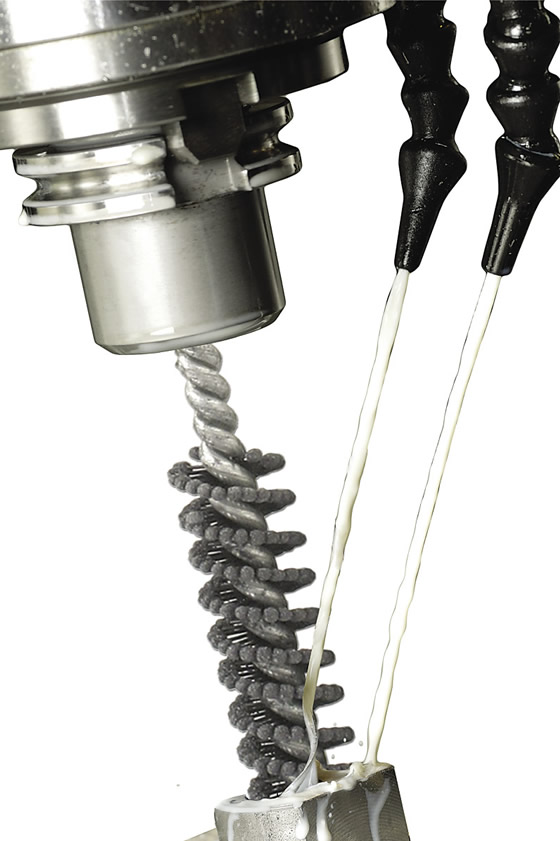END USER: Sikorsky Aircraft Corp., (800) 946-4337, www.sikorsky.com.
CHALLENGE: Efficiently remove scale from the bearing surface of a high-volume, 9310 alloy steel part.
SOLUTION: A custom diamond honing tool.
SOLUTION PROVIDER: Brush Research Manufacturing Co. Inc., (323) 261-2193, www.brushresearch.com.
Sometimes, the most experienced technicians and skilled toolmakers must turn to outside specialists when solving critical service problems. Such was the case when Sikorsky Aircraft Corp. had a problem cleaning the scale off of a carburized bearing surface in a 4.5mm (0.18 ") bore on a high-volume outsourced part, preventing the Stratford, Conn.-headquartered company from proceeding with production of its helicopters.
Sikorsky attempted to remove this scale with a carbide reamer and a diamond lap, according to Tony Lawrence, tooling services manager for Sikorsky Product Center Core Services. However, the long cycle times for those tools made them impractical for the large quantity of bores that needed rework.

Sikorsky Aircraft designs and builds helicopters for commercial, industrial and military use.
He explained that the part is made of 9310 alloy steel with a hardness of about 66 HRC, and, therefore, requires a tool with suitable hardness to properly remove the scale. Previously, Lawrence’s group successfully used diamond Flex-Hones from Brush Research Manufacturing Co. Inc. in a limited set of applications and decided to try the tool in this high-volume job.
The ball-style tool is characterized by a shaft with small, abrasive globules permanently mounted to flexible filaments. According to the toolmaker, the tool can be mounted in an electric hand drill motor, which is how Sikorsky needed to apply it, or in a machine tool chuck for resurfacing hard metals, ceramics and other challenging materials. The tool can impart surface finishes as fine as 0.1µm Ra.
For Sikorsky’s application, Brush Research constructed the special flexible hone with 170/200 diamond grit. The 0.18 "-dia. tool has an overall length of 6 " and a 2 "-long brush section.

Brush Research Manufacturing’s diamond Flex-Hone tool can be mounted in a machine tool chuck or hand drill motor for finishing or resurfacing hard and difficult-to-machine materials.
The toolmaker offers a free service for customers in which it uses surface analysis equipment to test tools on the material to be honed and show exactly what a customer is dealing with. “Surface finish analysis will give you roughness in micron Ra and a variety of other measurements, including peak height and valley depth,” said Grant Fowlie, customer service manager at Brush Research.
However, Sikorsky was unable to use this service because “time was of the utmost importance,” Fowlie said. “They did tests themselves after a phone conversation with our technical department.”
During the testing, Sikorsky was able to completely remove the scale with the flexible hone, according to Fowlie.
“After we had the first success, we needed Brush Research to produce thousands of these flexible hones since we were at a production stop,” Lawrence said. “Two days later, we had the first production run of brushes and were able to ship our product again to customers all over the world.”
For the Sikorsky project, producing thousands of flexible hones put a slight strain on the Brush Research staff, but Fowlie explained that the company is geared to quick turnaround because its facilities are consolidated in Los Angeles, where orders can be efficiently coordinated. “We have the ability to tweak our production schedule, add overtime easily and find ways to solve customers’ issues as quickly as possible,” he said. “With Sikorsky, we had direct communication regarding explicit quantities that they needed and timing for when those requirements were due.”
Fowlie added that this communication enabled Brush Research’s production scheduling and shipping departments to expedite tool production and ship them to multiple locations.
“This product worked better than expected,” Lawrence said, “and the Brush Research Manufacturing folks were unbelievably responsive.”
Related Glossary Terms
- abrasive
abrasive
Substance used for grinding, honing, lapping, superfinishing and polishing. Examples include garnet, emery, corundum, silicon carbide, cubic boron nitride and diamond in various grit sizes.
- ceramics
ceramics
Cutting tool materials based on aluminum oxide and silicon nitride. Ceramic tools can withstand higher cutting speeds than cemented carbide tools when machining hardened steels, cast irons and high-temperature alloys.
- chuck
chuck
Workholding device that affixes to a mill, lathe or drill-press spindle. It holds a tool or workpiece by one end, allowing it to be rotated. May also be fitted to the machine table to hold a workpiece. Two or more adjustable jaws actually hold the tool or part. May be actuated manually, pneumatically, hydraulically or electrically. See collet.
- hardness
hardness
Hardness is a measure of the resistance of a material to surface indentation or abrasion. There is no absolute scale for hardness. In order to express hardness quantitatively, each type of test has its own scale, which defines hardness. Indentation hardness obtained through static methods is measured by Brinell, Rockwell, Vickers and Knoop tests. Hardness without indentation is measured by a dynamic method, known as the Scleroscope test.
- micron
micron
Measure of length that is equal to one-millionth of a meter.
- reamer
reamer
Rotating cutting tool used to enlarge a drilled hole to size. Normally removes only a small amount of stock. The workpiece supports the multiple-edge cutting tool. Also for contouring an existing hole.







